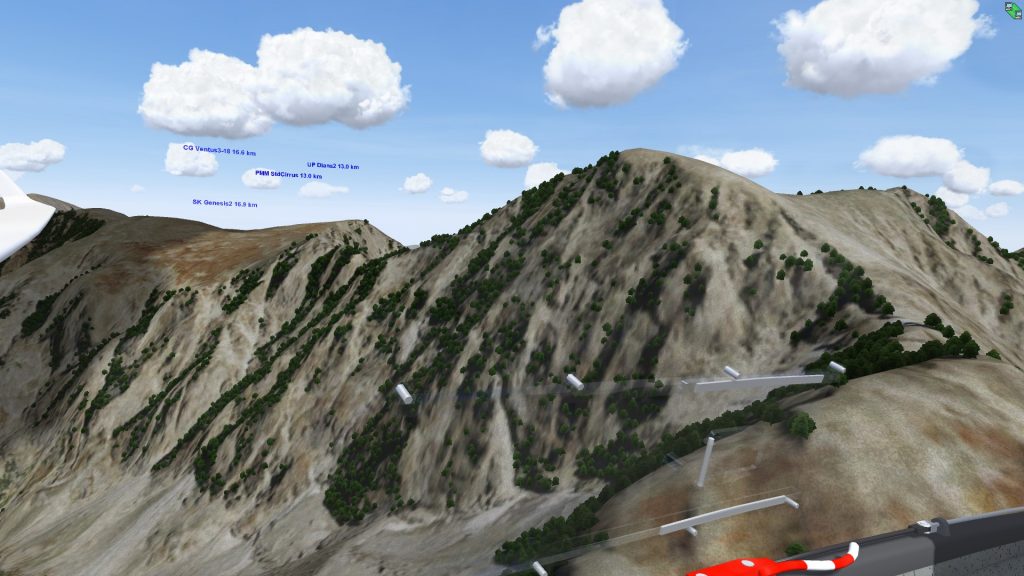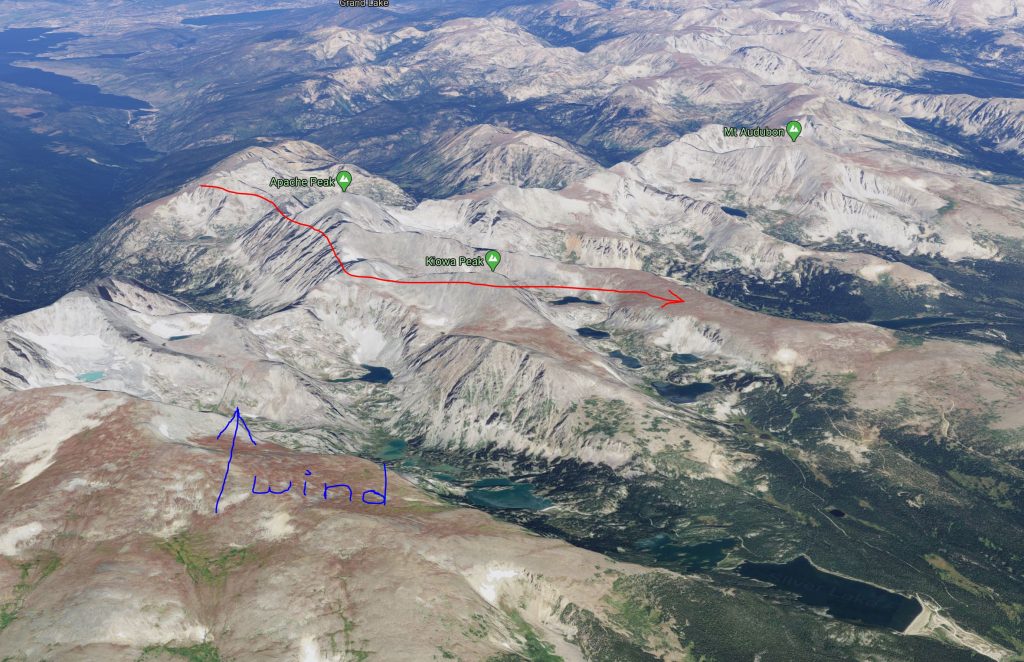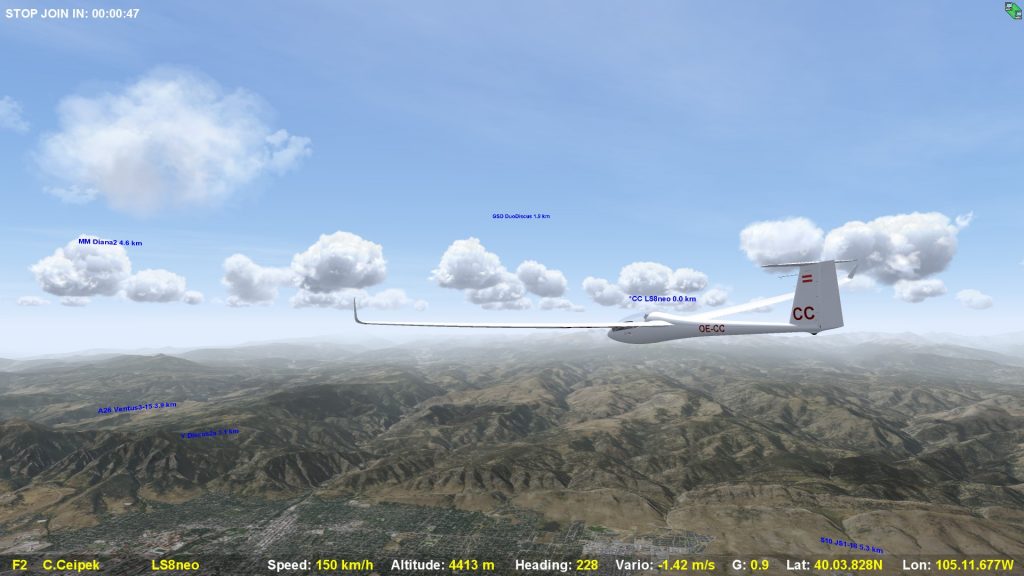Our most recent SSB Condor Club Flight took us across the Continental Divide. Once again we had 15 club members join the fun and 13 pilots successfully completed the task. Seven finished without using thermal helpers or other miracles. Well done! The results are here.
I noticed many pilots made big improvements since last week!
Scott Snyder had an outstanding (and miracle-free) flight completing the run from Boulder to Granby and back in a Duo Discus (i.e., no flaps) in less than 45 minutes. His average speed was over 100 miles per hour (163 kph). Despite starting ahead of the pack, and thus unable to use other gliders as thermal markers, he managed to score one of the best average climb rates of just over 10 kts. (Obviously, the simulated weather conditions were exceptionally strong. In real life, there will at best be a handful of days during the year when such speeds are possible.)
If you want to improve your cross-country speed, one way to do so is to look at your stats on the score sheet, compare them to those of others, and see where you have room for improvement. Here’s a legend as to what they mean with some tips how you can improve. All the tips are relevant for real life flying as well.
- mCR: mean climb rate of the whole flight. This measures a combination of a) how selective you are in taking good climbs; b) how effective you are in entering them (e.g. pulling up before banking and turning the right way the first time); c) how quickly you center them and keep them centered (while flying at optimum air speed and bank angle); and d) (to a lesser extent) how efficient you are in leaving thermals (exiting through the core and accelerating before hitting sink). One good way to way to improve your mCR is to enter thermals that are already marked by other gliders especially if you are confident that the pilots who arrived before you have them centered correctly. In this case you want to approach to the side of the thermal, pull up and then bank such that your first circle is already perfectly aligned with the other glider(s) in that thermal. (It definitely takes practice to get better at this but reducing the time to center thermals is often one of the most impactful ways to improve performance.)
- mGN: mean gliding number (without influence of wind). This is the actually achieved glide ratio – it is obviously a function of the performance of the glider and your speed and therefore not very meaningful as a comparison (unless you compare your flight with pilots who flew the same ship and achieved similar speeds overall). DeltaGN (see below) is much more meaningful.
- mIAS: mean indicated airspeed (the true airspeed is obviously higher depending on the altitude). To fly faster, try to fly MacCready speed between thermals and set your MC to the expected average climb rate in the next thermal (make some allowance for inefficiencies during thermal centering and do not set it to the maximum expected climb rate).
- nLift: number of lifts (i.e. the number of climbs that you took to complete the task) – this is helpful as a comparison because it almost always takes some time until you have a climb perfectly centered. So all other things being equal you tend to be faster if you take fewer climbs. (However, don’t linger in a weak climb if you don’t have to.)
- DeltaGN: Difference between mGN and the given glide ratio according to the glider’s speed polar. In totally still air this number would be zero at any speed. However, if you fly a straight line in-between thermals this number tends to be negative because the air between thermals is on average going down to compensate for the air that is going up within thermals. (What goes up must come down.) Therefore, you want to fly along energy lines where this is not the case, even if it requires a certain amount of course deviations. If you do this successfully, you will be able to achieve a positive DeltaGN. E.g., on yesterday’s flight my DeltaGN was positive because I followed the terrain during my Divide Crossings. The wind was from the south, as was the sun, so it paid off to fly on the windward (and sun-facing) side of the ridge lines. (This is a key reason why my flight was a bit faster than Scott’s even though Scott had a higher average climb rate and took fewer detours.)
- Vmet: average of rising and sinking air. This tells you basically the same thing as DeltaGN just with a different metric. If you follow energy lines during your inter-thermal cruise sections you can manage to be in rising air on average.
- AltLift: average altitude gained per thermal. This tells you a similar thing as nLift. I.e., since it takes time to center lift it tends to be inefficient to take more climbs than necessary. If nLift is relatively small, AltLift will be relatively high (and vice versa). However, be careful not to push this to the extreme. If you try to take as few climbs as possible you are pushing your luck: the lower you get the fewer options you have left if a climb you have been counting on does not work out. (E.g., as clouds age, the lift may no longer come from the surface and you might arrive too low to connect with it.) This increases your risk of having to land out or being forced to take a sub-average climb to dig yourself out. Also, in most cases the lift near the surface tends to be narrower and weaker than in the middle and upper part of the band. The Golidlocks approach tends to be best: take only the climbs than are average or better than average and leave a climb when you are confident that the climb rate in the next climb will be noticeably better than the one that you are leaving.
- Detour: Detour in percent, only gliding passages are regarded. All things being equal you will fly faster by taking the most direct route (i.e., no detour). However, minor detours to follow energy lines almost always pay off even if the energy line just means a reduced rate of sink. It takes practice to judge what detours are worth it and when it is best to just fly straight.


If you want to refly the task, you can download the flightplan here.
Next week, we’ll do something different. Instead of flying a task as fast as possible, we’ll take a land-out tour to the south where we will try to land our gliders in various fields, model aircraft runways, and other strange places. This will be a lot of fun and a great target landing practice. Make sure you’ve practiced these exercises in advance!


